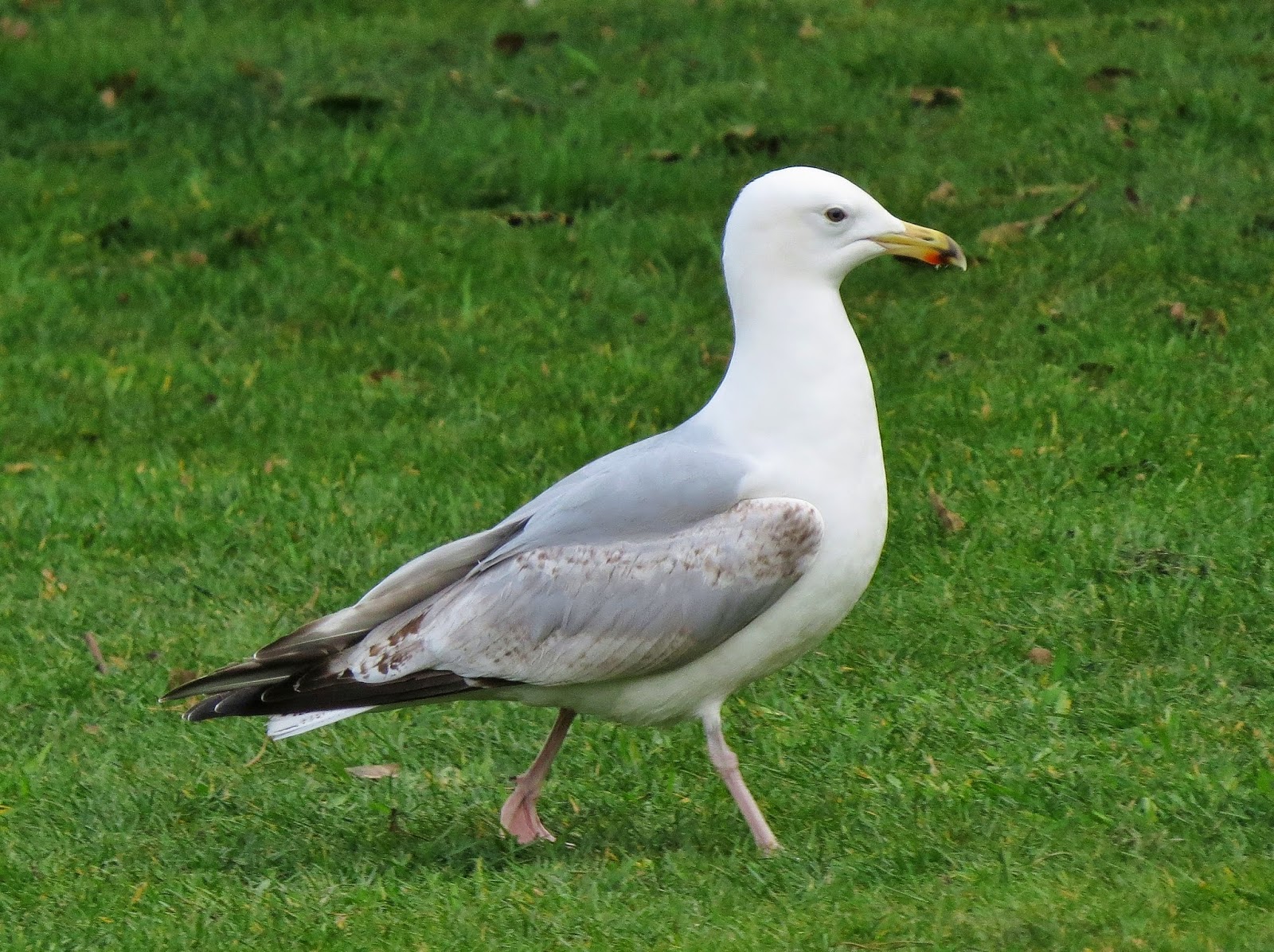Herring Gull (Larus argentatus) 2º cy flying in Bournemouth's beach.
Although the main reason of the trip was not the birdwatching, I took advantage of some moments to look for birds:
The coast.
The arrival day, I went for a walk accompanied with a friend for the riverbank of the river Stour.
We did not sight anything of interest; the typical birds of british gardens.
Grey Squirrels were common:
Jay (Garrulus glandarius).
Carrion Crow (Corvus corone).
Grey Heron (Ardea cinerea).
Robin (Erithacus rubecula).
Great-spotted Woodpecker (Dendrocopos major) female.
Wren (Troglodytes troglodytes).
Jackdaw (Corvus monedula) with partial leucism in primaries.
Grey Squirrels (Sciurus carolinensis).
The nearness of the birds attracted my attention. They were not run away, as in Spain tend to happen.
Probably this is due to the treatement they receive: Whereas in Spain they accept beatings and stone-throwings, in England they accept feeding places and nesting boxes.
Spanish people do not realize, but Spain possess the greatest biodiversity of the whole Europe, and to tell the truth, we do not do very much for preserving it...
The second day, I could know Christchurch priory. In the nearby river Avon, I saw a lot of Mute Swans, Herring Gulls and Black-headed Gulls. Also a Tufted Duck feeding calmy with Mallards in one of the canals:
Mute Swan (Cygnus olor).
Herring Gull (Larus argentatus) adults.
Black-headed Gull (Larus ridibundus) adult.
Tufted Duck (Aythya fuligula) male.
All the Mute Swans were ringed with metallic and PVC ring. Since they let me to approach, I could read the metallic ring, which indicated that they would have been ringed in England.
On the same evening, when I arrived home, I looked in the web cr-birding.org and confirmed his origin: these birds are ringed in the south-east of Great Britain.
After visiting Christchurch, I entertained myself with two Herring Gulls that were preening in a roof.
I took some curious photos:
Herring Gull (Larus argentatus) adult.
This species and the Black-headed Gull were the most frequent birds in the whole trip, and also those that more time I dedicated, especially to the Herring Gull, which was a species I only had observed once previous and in bad conditions, in Santander's bay.
I only annotated a new species for my list, the Fulmar. It was at Jurasic Coast.
When all my schoolmates were taking photos of the landscape, I was trying to sight some seabirds; among the abundant Herring Gulls, there were flush with water other different smaller birds and with a different way of flight.
They were the Fulmars, incredibly birds:
Fulmars (Fulmarus glacialis).
In the same place, I made out in the distance an Oysterchatcher:
Eurasian Oystercatcher (Haematopus ostralegus).
And it had not time to any more in five minutes of observation.
And finally, to end this post, several photos with all the ages of Herring Gull that can be differentiate based on its plumage, and the colour of its iris, bill and legs (except the first year, logically): the second year, the third year, the fourth year, the fifth year and the adult:
2º cy:
Some flights:
In that photo the pale inner primary window is obvious...
3º cy:
With a 2º cy (left).
With a Black-headed Gull (Larus ridibundus).
Some flights:
4º cy:
With an adult.
5º cy:
Adult:
Now Black-headed Gull ages:
2º cy:
Adult:
This bird was ringed in the right tarsus.
But for the enormous quantity of photos I took, I could not have read the metallic ring.
Now I'm waiting for its life history.
I only watched two more species of gulls: the two Black-backed Gulls:
Great Black-backed Gull (Larus marinus) adult.
Lesser Black-backed Gull (Larus fuscus graellsii) 4º cy.
Although I did not see a lot of variety, I could entertain, observing and taking photographs to the Herring Gulls, and especially learning on them and its complicated plumages.
Greetings!
Miguel.




















































































Hi friend,as I can see,your travel has been very busy,with a lot of great photos,congratulations about it!!!
ResponderEliminarI Would like yo know what of those photos do I have yo paint for you;)jejeje
Greetings crack
Thank you Dyck!
EliminarI will choose the photo where a 2°cy Herring Gull is landing on the iron bar.
Greetings!
Really nice gull pics.....and congratulations for your new lifer, the fulmar,,,incredible pelagic bird.
ResponderEliminarSaludos camperos!
Nice blog entry, Miguel! You managed to get good shots of the herring gulls.
ResponderEliminarGreetings!
Si ya te lo decía yo... pareciese que llevas toda la vida con la cámara que, sin duda, ya tienes dominada (a mi me costó mucho más tiempo lograr esa nitidez con las aves en vuelo).
ResponderEliminarQue conste que a mi lo de las gaviotas no me atrae especialmente (es que soy de Ferrol), pero me encantó la Ardilla gris. Y la próxima vez tráete un tritoncillo de los que tienen por allí (una foto de él, me refiero)
Un saludo
PD: Tenías un 500 con la reflex, ¿no? ;)
Hola Xabi:
EliminarSupongo que te refieres al Northern Crested Newt (Triturus cristatus) o al Common Newt (Tritutus vulgaris).
No sé si habrá próxima vez. Espero que sí ;-)
Aún no la tengo dominada. Me falta mucho, pero poco a poco.
UN Saludo.
hi Miguel!
ResponderEliminarbeautiful entrance with stunning photos of gulls!!you are a crack!
Squirrel photo is beautiful too, but for me the photos of gulls are the best
Greetings!